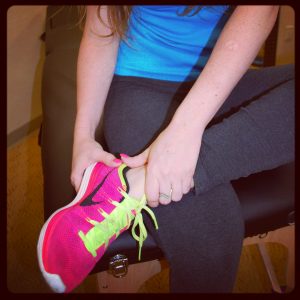 This will go over the major injuries and causes of pain that you need to be aware of to help you be aware of conditions, solving your pain, and to help avoid injury when starting a walking or running program!
This will go over the major injuries and causes of pain that you need to be aware of to help you be aware of conditions, solving your pain, and to help avoid injury when starting a walking or running program!
Many people can complain of symptoms of:
- back and leg pain,
- numbness and tingling
- a dull ache
- tightness
- joint pain
- leg pain in one or both legs
- sharp foot and heel pain
- cramping in the buttocks and leg area.
RED FLAGS
 These are serious pathologies that need to be addressed if you are having pain during your walking or running program. Consult with you physician if you present with any of these symptoms. Leg pain is very common symptom and be caused from many different factors:
Peripheral Vascular Disease (PVD) – in medicine this is termed vascular claudication. This can be similar to pain that is coming from the low back especially as we increase in age and with a diagnosis of lumbar stenosis (narrowing), but you can differentiate. So if you start walking and you begin to experience leg pain, what changes your symptoms? If you stop and remain still does your pain, resolve? If you keep walking and your pain returns, does sitting on a bench, resolve your pain? Do you experience the same pain when riding a bike or walking on an inclined treadmill? Pay attention to your symptoms in these cases and your results will tell a lot.
Bone Pain – if you feel that you have bone pain after starting a walking or running program, you have to consult your physician to rule out serious pathologies like a stress fracture, Paget’s Disease, and other metabolic bone disorders.
Blood Clots or DVT – Many people do have blots clots and don’t even know. Follow these rules and if you have >3 major criteria and > 2 minor criteria, consult your physician due to being a high risk of a DVT prior to starting a exercise program. This is considered a medical emergency.
These are serious pathologies that need to be addressed if you are having pain during your walking or running program. Consult with you physician if you present with any of these symptoms. Leg pain is very common symptom and be caused from many different factors:
Peripheral Vascular Disease (PVD) – in medicine this is termed vascular claudication. This can be similar to pain that is coming from the low back especially as we increase in age and with a diagnosis of lumbar stenosis (narrowing), but you can differentiate. So if you start walking and you begin to experience leg pain, what changes your symptoms? If you stop and remain still does your pain, resolve? If you keep walking and your pain returns, does sitting on a bench, resolve your pain? Do you experience the same pain when riding a bike or walking on an inclined treadmill? Pay attention to your symptoms in these cases and your results will tell a lot.
Bone Pain – if you feel that you have bone pain after starting a walking or running program, you have to consult your physician to rule out serious pathologies like a stress fracture, Paget’s Disease, and other metabolic bone disorders.
Blood Clots or DVT – Many people do have blots clots and don’t even know. Follow these rules and if you have >3 major criteria and > 2 minor criteria, consult your physician due to being a high risk of a DVT prior to starting a exercise program. This is considered a medical emergency.
Major Criteria • Active cancer within last 6 months • Paralysis • Recently bedridden • Localized tenderness • Thigh and calf are swollen • Strong family history of DVT
Minor Criteria • History of recent trauma • Pitting edema • Dilated superficial veins • Hospitalized within last 6 months • Erythema
 These are less serious causes of your leg pain and can be treated many times without surgery or injections and with some good physical therapy
Lumbar Stenosis – As described in the red flag section of PVD, lumbar stenosis can cause leg pain with walking. Symptoms, which are posture-dependent, are worsened with extension of the lumbar spine or weight-bearing postures of the spine. Symptoms are decreased with flexion (sitting or bending forward) or non-weight-bearing postures of the spine.
Patients may feel pain, cramping, weakness or numbness in the lower back and legs. Usually with a this diagnosis, people with complain of this pain with prolonged standing, walking and report that it resolves or decreases with sitting and bending forward.
These are less serious causes of your leg pain and can be treated many times without surgery or injections and with some good physical therapy
Lumbar Stenosis – As described in the red flag section of PVD, lumbar stenosis can cause leg pain with walking. Symptoms, which are posture-dependent, are worsened with extension of the lumbar spine or weight-bearing postures of the spine. Symptoms are decreased with flexion (sitting or bending forward) or non-weight-bearing postures of the spine.
Patients may feel pain, cramping, weakness or numbness in the lower back and legs. Usually with a this diagnosis, people with complain of this pain with prolonged standing, walking and report that it resolves or decreases with sitting and bending forward.
Compartment syndrome – Compartment syndrome of lower leg, is the compression of nerves, blood vessels, and muscle(s) inside a closed space (compartment) within the body. This injury may lead to tissue death (necrosis) due to the blood vessels being compressed by the raised pressure within the compartment. So this compression causes an ischemia, a lack of oxygen, that can result in serious and dangerous tissue damages or tissue death when this injury isn’t treated well. Compartment syndrome most often involves the forearm and lower leg, and can be divided into acute, subacute, and chronic compartment syndrome. This syndrome occurs fairly regularly and occurs in most of the times in athletes, such as long distance runners, soccer players and basketball players. It can also occur in children, adolescents or adults, but more often in adults
Shin Splints – Shin-splints is a general term for overuse injuries of the lower leg, except stress fractures and compartmental syndrome. A synonym for shin-splints is: medial tibial stress syndrome. Many specialist say: “A more descriptive term that accounts for the inflammatory, traction event on the tibial aspect of the leg common in runners is medial tibial traction periostitis or just medial tibial periostitis “. There are five possibilities which can describe the experienced shin pain: bone stress, inflammation, vascular insufficiency, nerve entrapment and a raised intracompartmental pressure Arthritis or joint pain – Many people complain of joint pain with increased activity but this does not mean you have to suffer from pain. Arthritis or joint pain is specific to each joint and may be accompanied but joint tenderness and swelling. An x-ray (radiograph) is used to diagnosis this and after physical therapy to correct the biomechanics many people can get back to have the range of motion and strength needed to return to their waling program Heel pain and Foot Pain – There can be many different cases that cause foot and heel pain when walking. the most common case is plantar fasciitis and 90% of cases can resolve with conservative care. This is when the plantar fasciitis becomes irritated on the bottom of the heel where it initiates from. Research has shown this to not be an inflammatory case so gentle stretching and heat may help resolve your pain. The longer you wait and more chronic the case becomes the longer it takes to recover. A Morton’s neuroma, bone spur, ankle sprain, stress fracture, and bunions may also be causes of your heel and foot pain
 What is the single best thing to do for your health?
Hint: if you are reading this blog you probably are doing it already!
Resources:
http://www.physio-pedia.com/Main_Page
What is the single best thing to do for your health?
Hint: if you are reading this blog you probably are doing it already!
Resources:
http://www.physio-pedia.com/Main_Page 






